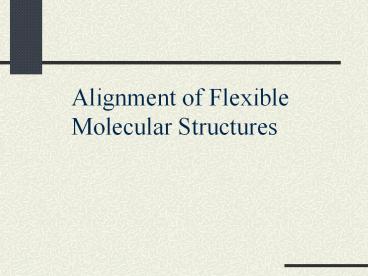Exact%20Point%20Matching%20in%20R2 - PowerPoint PPT Presentation
Title:
Exact%20Point%20Matching%20in%20R2
Description:
One would like to align proteins modulo the flexibility. Hinge and shear protein domain motions (Gerstein, Lesk , Chotia) ... Solid Angle local extrema. knob. hole ... – PowerPoint PPT presentation
Number of Views:27
Avg rating:3.0/5.0
Title: Exact%20Point%20Matching%20in%20R2
1
Alignment of Flexible Molecular Structures
2
Motivation
- Proteins are flexible. One would like to align
proteins modulo the flexibility. - Hinge and shear protein domain motions
(Gerstein, Lesk , Chotia). - Conformational flexibility in drugs.
3
Problem definition
4
Flexible Geometric Hashing
- Exploit the fact that neighboring parts share the
joint - accumulate mutual information at the
joint. - Achieve complexity of the same order of magnitude
as in rigid alignment.
5
Flexible protein alignment without prior hinge
knowledge
- FlexProt - algorithm
- detects automatically flexibility regions,
- exploits amino acid sequence order.
6
Motivation
7
Geometric Representation
3-D Curve vi, i1n
8
Experimental Results
9
Experimental Results
10
FlexProt Algorithm
- Input two protein molecules A and B, each being
represented by the sequence of the 3-D
coordinates of its Ca atoms. - Task largest flexible alignment by decomposing
the two molecules into a minimal number of rigid
fragment pairs having similar 3-D structure.
11
(No Transcript)
12
FlexProt Main Steps
Detection of Congruent Rigid Fragment Pairs
Joining Rigid Fragment Pairs
Rigid Structural Comparison
Clustering (removing ins/dels)
13
Structural Similarity Matrix
14
Detection of Congruent Rigid Fragment Pairs
i1
i-1
i
j-1
j1
j
vi-1 vi vi1 wj-1 wj wj1
15
RMSD Computation
Vi ... Vil Wj ... Wjl
Vk ... Vkm Wt ... Wtm
P
Q
P U Q
16
FlexProt Main Steps
Detection of Congruent Rigid Fragment Pairs
Joining Rigid Fragment Pairs
Rigid Structural Comparison
Clustering (removing ins/dels)
17
How to Join Rigid
Fragment Pairs ?
18
Graph Representation
Graph Node
Graph Edge
19
Graph Representation
- The fragments are in ascending order.
- The gaps (ins/dels) are limited.
- Allow some overlapping.
W
a
b
Size of the rigid fragment pair (node b) - Gaps
(ins/dels) - Overlapping
Penalties
20
Graph Representation
- DAG (directed acyclic graph)
21
Optimal Solution ?
W_k
W_m
W_n
W_t
W_i
- All Shortest Paths
- O(EVV2) (for DAG)
- Single-source shortest paths
- O(EV)
22
FlexProt Main Steps
Detection of Congruent Rigid Fragment Pairs
Joining Rigid Fragment Pairs
Rigid Structural Comparison
Clustering (removing ins/dels)
23
Clustering (removing ins/dels)
T1
T2
If joining two fragment pairs gives small RMSD
(T1 T2) then put them into one cluster.
24
FlexProt Main Steps
Detection of Congruent Rigid Fragment Pairs
Joining Rigid Fragment Pairs
Rigid Structural Comparison
Clustering (removing ins/dels)
25
Correspondence Problem
26
Molecular Surface Representation
- Applications to docking
27
Motivation
- Prediction of biomolecular recognition.
- Detection of drug binding cavities.
- Molecular Graphics.
28
1. Solvent Accessible Surface SAS2.
Connolly Surface
29
Connollys MS algorithm
- A water probe ball (1.4-1.8 A diameter) is
rolled over the van der Waals surface. - Smoothes the surface and bridges narrow
inaccessible crevices.
30
Connollys MS algorithm - cont.
- Convex, concave and saddle patches according to
the no. of contact points between the surface
atoms and the probe ball.
- Outputs pointsnormals according to the
- required sampling density (e.g. 10 pts/A2).
31
Example - the surface of crambin
32
Critical points based on Connolly rep. (Lin,
Wolfson, Nussinov)
- Define a single pointnormal for each patch.
- Convex-caps, concave-pits, saddle - belt.
33
Critical point definition
34
Connolly gt Shou Lin
35
Solid Angle local extrema
hole
knob
36
Chymotrypsin surface colored by solid angle
(yellow-convex, blue-concave)

